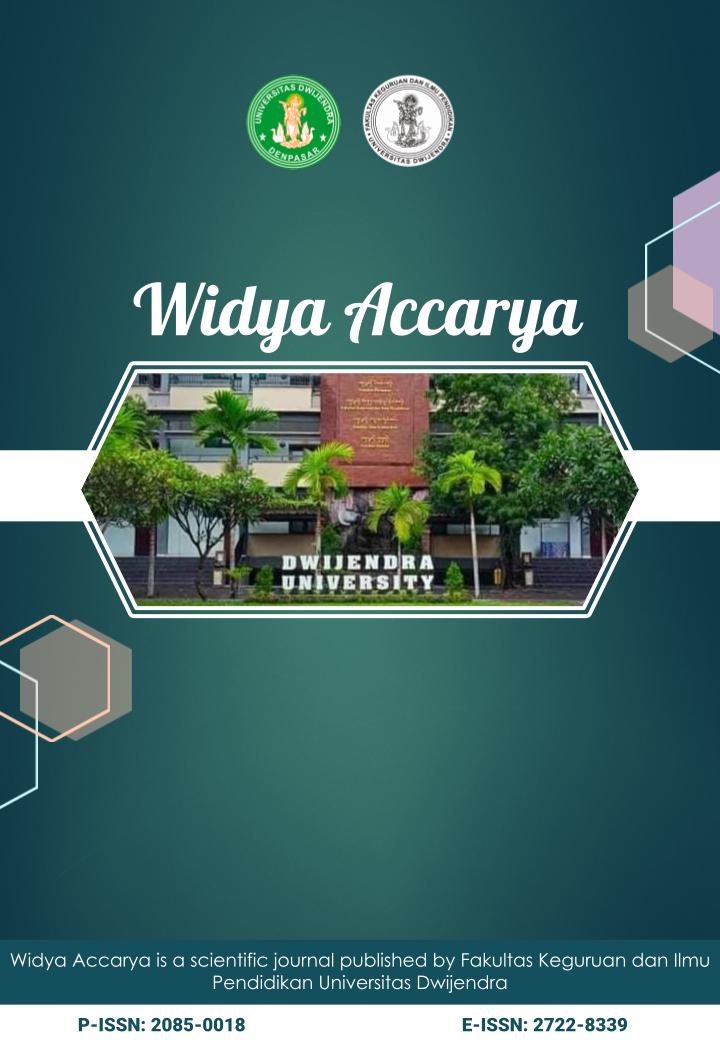Meningkatkan Kemampuan Menulis Cerita Fantasi dengan Model Pembelajaran Project Based Learning pada Siswa Kelas VII B SMP Dwijendra Denpasar Tahun Pelajaran 2024/2025
DOI:
https://doi.org/10.46650/wa.16.2.1735.216-235Keywords:
cerita fantasi, proyek based learning, penelitian tindakan kelas, struktur cerita fantasiAbstract
References
Arikunto, S. (2013). Prosedur Penelitian: Suatu Pendekatan Praktik (Edisi Revisi). Jakarta: Rineka Cipta.
Burns, A., & Rochsantiningsih, D. (2006). Conducting action research in Indonesia: Illustrations and implications. Indonesian Journal of English Language Teaching, 2(1), 21-35.
Creswell, J. W. (2012). Educational Research: Planning, Conducting, and Evaluating.
Darling-Hammond, L., Barron, B., Pearson, P. D., Schoenfeld, A. H., Stage, E. K., Zimmerman, T. D., Cervetti, G. N., and Tilson, J. L. (2008). Powerful learning: 67 What we know about teaching for understanding. San Francisco, CA: JosseyBass.
Gereda, A. (2014). Kemampuan Menulis Deskripsi Mahasiswa Program Studi Pendidikan Bahasa Dan Sastra Indonesia Universitas Muspas. Jurusan Pendidikan Bahasa dan Sastra Indonesia, Volume 2 Nomor 1, 125 - 137.
Harsiati, dkk. (2016). Bahasa Indonesia. Jakarta: Kementerian Pendidikan dan Kebudayaan .
Irma, Ana, H., & Yunus. 2019. Jurnal BASTRA (Bahasa dan Sastra) : http://ojs.uho.ac.id/index.php/BASTRA. Jurnal Bastra, 4(2), 268–283.
Krajcik, J. S., and Shin, N. (2014). Project-based learning. In R. K. Sawyer (Ed.), The Cambridge handbook of the learning sciences (2nd ed.) (pp. 275-297). New York, NY: Cambridge University Press.
Larmer, J., and Mergendoller, J. R. (2015a). Gold standard PBL: Essential project design elements. Buck Institute for Education. Retrieved from www.bie.org.
Laila, N. A., & Ibrahim, N. (2021). Struktur dan Kaidah Kebahasaan Cerita Rakyat dalam BSE Bahasa Indonesia Kelas X SMA Tahun Pelajaran 2020/2021. Jurnal Pendidikan Bahasa dan Sastra Indonesia Undiksha, 11(4), 395. https://doi.org/10.23887/jjpbs.v11i4.37179
Moleong, L. J. (2017). Metodologi Penelitian Kualitatif (Edisi Revisi). Bandung: PT Remaja Rosdakarya.
Miles, M. B., Huberman, A. M., & Saldaña, J. (2014). Qualitative Data Analysis: A Methods Sourcebook (3rd ed.). Thousand Oaks, CA: SAGE Publications.
Novita, E., & Nursaid, N. 2020. Struktur, Unsur, dan Tipe Teks dalam Teks Cerita Fantasi Karya Siswa Kelas VII SMP Negeri 7 Padang. Pendidikan Bahasa Indonesia, 9(3), 55. https://doi.org/10.24036/110720-019883
Niranjanii, N. K. S., Wisudarianiii, N. M. R., & Nurjayaiii, I. G. (2022). Analisis Kanal Dongeng Kita sebagai Bahan Materi Teks Cerita Fabel pada Pembelajaran Bahasa Indonesia di SMP. Stilistika, 10(2), 334–345.
Parker, W. C., Lo, J., Yeo, A. J., Valencia, S. W., Nguyen, D., Abbott, R. D., Nolen, S. B., Bransford, J. D., and Vye, N. J. (2013). Beyond breadth-speed-test: Toward deeper knowing and engagement in an advanced placement course. American Educational Research Journal, 50(6), 1424-1459.
Parker, W. C., Mosborg, S., Bransford, J., Vye, N., Wilkerson, J., and Abbott, R. (2011). Rethinking advanced high school coursework: Tackling the depth/breadth tension in the AP US government and politics course. Journal of Curriculum Studies, 43(4), 533-559.
Pellegrino, J. W., and Hilton, M. L. (Eds.). (2012). Education for life and work: Developing transferable knowledge and skills in the 21st century. Washington, DC: National Academies Press.
Pratiwi, B. A., Sumiyadi, & Nugroho, R. A. (2024). Pembelajaran Diferiensiasi Berbasis Proyek untuk Pengembangan Keterampialan Menulis Cerita Pendek di SMP. Jurnal Onama, Vol.10,No.3.
Ravitz, J. (2010). Beyond changing culture in small high schools: Reform models and changing instruction with project-based learning. Peabody Journal of Education, 85(3), 290-312.
Sanjaya, W. (2010). Penelitian Tindakan Kelas. Jakarta: Kencana.
Saputra, E. (2014). Pembelajaran Menulis Bahasa Indoensia. JURNAL AL – IRSYAD, Vol. IV, No. 1,, 70 -89.
Siska, K., Dewi, Y., Ayu, S., Sriasih, P., & Wendra, W. (2023). Analisis Siniar “Dongeng Anak Masa Kini” Sebagai Media Ajar dalam Pembelajaran Cerita Fantasi di SMP https://ejournal.undiksha.ac.id/index.php/JJPBSR&D. Bandung: Alfabeta.
Sugiyono. (2017). Metode Penelitian Pendidikan: Pendekatan Kuantitatif, Kualitatif, dan R&D). Alfabeta.
Sumiyati, S., Meilani, W., & Siagian, I. (2021). Pelaksanaan Pembelajaran Teks Cerita Fantasi di Kelas VII B SMPN 276 Jakarta. Jurnal Pendidikan Indonesia, 2(12), 2082–2091. https://doi.org/10.59141/japendi.v2i12.399.
Syarifah, L., Holisin, I., & Shoffa, S. (2021). Meta Analisis: Model Pembelajaran Project Based Learning. Jurnal Penelitian Pembelajaran Matematika, 14 Nomor 2, 256 -272.
Thomas, J. W. (2000). A review of research on project-based learning. San Rafael, CA: The Autodesk Foundation.
Yuan, R., & Burns, A. (2017). Teacher identity development through action research: A Chinese experience. Teachers and Teaching: Theory and Practice, 23(6), 729–749. https://doi.org/10.1080/13540602.2016.1219713
Downloads
Published
How to Cite
Issue
Section
Citation Check
License
Copyright (c) 2025 I Ketut Suar Adnyana, I Gusti Ayu Putu Istri Aryasuari, Ni Nyoman Ayu Riptayani

This work is licensed under a Creative Commons Attribution-ShareAlike 4.0 International License.
An author who publishes in the Widya Accarya agrees to the following terms:
- Author retains the copyright and grants the journal the right of first publication of the work simultaneously licensed under the Creative Commons Attribution-ShareAlike 4.0 License that allows others to share the work with an acknowledgement of the work's authorship and initial publication in this journal
- Author is able to enter into separate, additional contractual arrangements for the non-exclusive distribution of the journal's published version of the work (e.g., post it to an institutional repository or publish it in a book) with the acknowledgement of its initial publication in this journal.
- Author is permitted and encouraged to post his/her work online (e.g., in institutional repositories or on their website) prior to and during the submission process, as it can lead to productive exchanges, as well as earlier and greater citation of the published work (See The Effect of Open Access).
Read more about the Creative Commons Attribution-ShareAlike 4.0 Licence here: https://creativecommons.org/licenses/by-sa/4.0/.

















